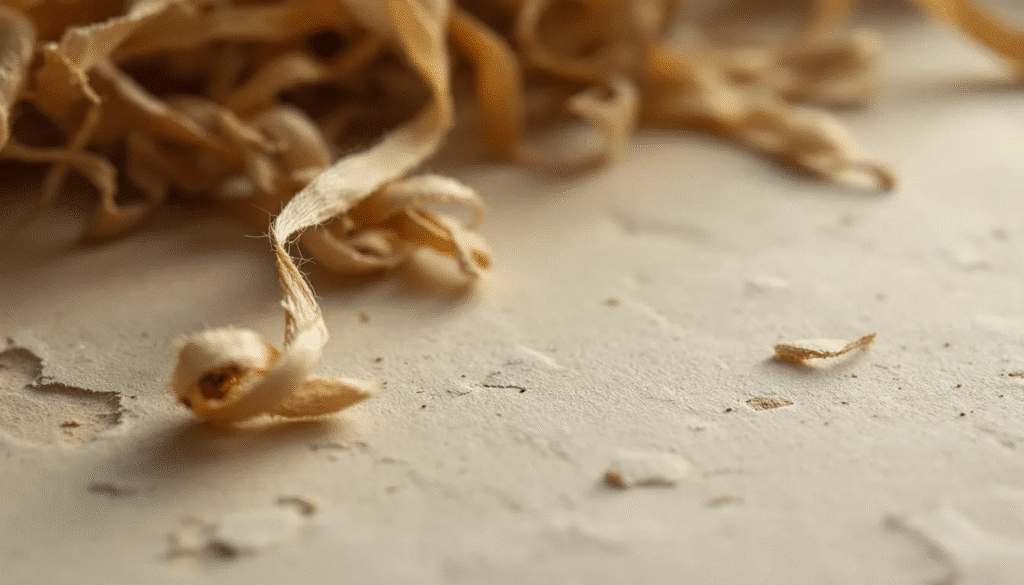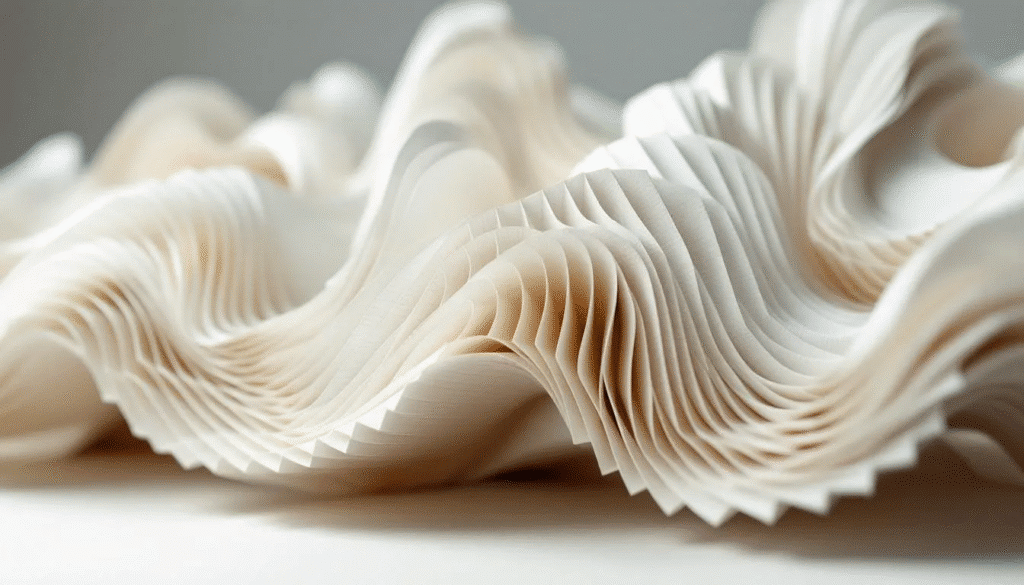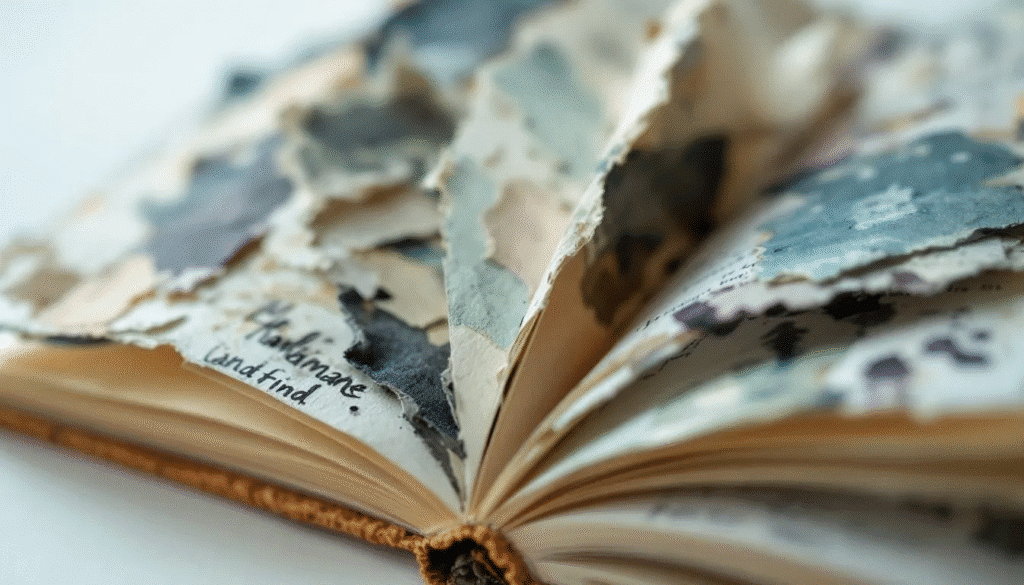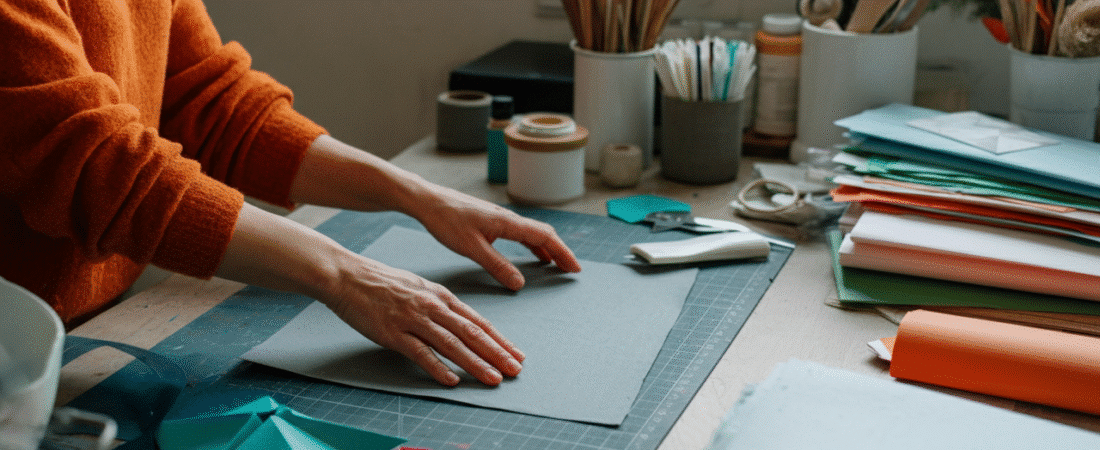Key Takeaways
- Papermaking artists transform raw plant fibers and recycled materials into sculptural artworks, installations, and unique paper surfaces that transcend traditional boundaries
- Contemporary papermaking artists like Helen Hiebert, Li Hongbo, and Paul Wong have revolutionized the medium by creating kinetic sculptures, installations, and three-dimensional works from handmade paper
- The craft combines ancient techniques dating back to 105 A.D. with modern innovations, allowing artists to explore themes of identity, nature, and cultural heritage through paper as a primary medium
- Professional papermaking artists often work with specialized studios like Dieu Donné in New York and use techniques ranging from traditional mould and deckle methods to contemporary pulp painting and laser cutting
- The field encompasses diverse applications from wearable art and book objects to large-scale environmental installations, making paper a versatile sculptural material rather than just a drawing surface
- What is a Papermaking Artist?
- Contemporary Papermaking Artists and Their Innovations
- Techniques and Materials in Paper Art
- Global Papermaking Art Scene
- Applications and Artistic Expressions
- Educational Resources and Community
- FAQ
- What materials do papermaking artists typically use beyond traditional wood pulp? craft paper supplies
- How long does it take to become proficient as a papermaking artist?
- What is the difference between industrial papermaking and artistic papermaking?
- Can papermaking art be preserved long-term like traditional paintings or sculptures?
- What are the most important studios or institutions for learning advanced papermaking techniques?
What is a Papermaking Artist?
A papermaking artist represents a unique fusion of ancient craft and contemporary art, transforming humble plant fibers and recycled materials into sophisticated three-dimensional sculptures, installations, and surface treatments. Unlike traditional papermakers who focus primarily on creating functional sheets for writing or printmaking, these artists approach paper as their primary art medium—a material capable of conveying complex themes of identity, memory, and the life cycle of natural materials. For those interested in exploring the art of paper crafting, a wealth of inspiration and tutorials is available online.
The distinction between commercial papermaking and artistic practice lies in the artist’s intent to explore paper’s sculptural potential. While traditional papermaking emphasizes consistency and function, papermaking artists embrace the medium’s capacity for texture, translucency, and dimensional manipulation. They work with specialty fibers like Japanese kozo, cotton rag, and even invasive plants, creating new shapes and forms that challenge conventional perceptions of what paper crafts can become.

The roots of this artistic practice trace back to 105 A.D. in China, when Cai Lun developed the first systematic papermaking process during the Eastern Han Dynasty. His innovation of boiling plant fibers to create a slurry, then forming sheets on screens, established the fundamental principles that contemporary paper artists still employ today. However, modern practitioners have expanded far beyond these historical boundaries, incorporating everything from laser cutting to digital integration into their work.
Contemporary papermaking artists operate at the intersection of fine art, craft, and material science. They might spend months developing the perfect pulp mixture for a specific installation, or create new life for discarded textiles by transforming them into sculptural elements. This approach positions paper not as a secondary substrate for paint or pencil, but as a primary medium worthy of exploration in its own right.
Contemporary Papermaking Artists and Their Innovations
The contemporary papermaking scene features artists who have pushed the boundaries of what’s possible with handmade paper, creating works that span from intimate book objects to room-sized installations. These innovators demonstrate how paper can function as a sculptural material, challenging traditional notions of the medium’s limitations.
Helen Hiebert stands at the forefront of contemporary paper artists, creating installations that incorporate thread, light, and handmade paper into immersive environments. Her work transforms gallery spaces into ethereal landscapes where paper becomes a vehicle for exploring natural phenomena. Hiebert’s sculptures often feature translucent papers that interact with lighting systems, creating shadows and reflections that change throughout the day. Her installations have been featured in museums worldwide, demonstrating how papermaking artists can create experiences that engage multiple senses.
Li Hongbo has revolutionized sculptural papermaking through his kinetic paper sculptures that expand like accordions. His famous reimagining of Michelangelo’s Bust of David appears as a classical sculpture until viewers witness its transformation into flowing, honeycomb-like forms. Li’s work exemplifies how contemporary paper artists can take familiar imagery and completely reimagine it through innovative manipulation of paper structure. His sculptures challenge perceptions of permanence and form, revealing hidden flexibility within seemingly solid objects.

Paul Wong represents the institutional memory of American papermaking artistry through his four-decade career at Dieu Donné studio in New York. Recently recognized as a Paper Champion in 2022, Wong has collaborated with hundreds of artists to realize their visions in handmade paper. His expertise spans traditional mould and deckle techniques to cutting-edge pulp painting methods. Wong’s work demonstrates how skilled craftspeople enable other artists to explore paper’s potential, creating a collaborative ecosystem that advances the entire field.
Roberto Benavidez creates piñata-inspired sculptures that reference Hieronymus Bosch’s Garden of Earthly Delights, combining Mexican folk traditions with European art historical themes. His work showcases how papermaking artists can address cultural identity and heritage through their choice of materials and forms. Benavidez’s sculptures demonstrate paper’s capacity to carry complex narratives while maintaining visual impact as standalone art objects.
Nate Lewis produces intricate paper portraits and protest imagery using embroidery-like cutting techniques. His work addresses contemporary social issues through meticulous hand papermaking processes, creating images that appear delicate but carry powerful political messages. Lewis’s practice shows how traditional craft techniques can be adapted to address current events and social justice themes.
Techniques and Materials in Paper Art
The technical foundation of artistic papermaking begins with the traditional mould and deckle process, where artists control every aspect of sheet formation. This ancient technique involves creating a slurry of beaten plant fibers in water, then using a framed screen (the mould) and removable border (the deckle) to form individual sheets. Contemporary papermaking artists have expanded this basic process into sophisticated methods for creating dimensional works.
Pulp painting represents one of the most significant innovations in artistic papermaking, pioneered at studios like Dieu Donné in New York. This technique involves pouring or brushing colored pulps directly into the mould to create imagery within the paper itself. Artists can build up layers of different colors and textures, creating works that function as both paintings and sculptural objects. The process requires precise timing and water management, as the pulp must maintain proper consistency throughout the creation process.
Material selection plays a crucial role in determining the final artwork’s character. While traditional papermakers often rely on cotton or wood pulp, papermaking artists explore diverse fiber sources including recycled textiles, invasive plant species, and specialty materials like abaca and kozo. Japanese Washi papers, made from mulberry fibers, offer exceptional strength and translucency that many artists prize for large-scale installations.

Contemporary artists frequently integrate mixed media elements into their papermaking practice. Some embed photographs, fabrics, or even three-dimensional objects directly into the paper during formation. Others combine traditional papermaking with encaustic painting, printmaking, or digital processes. Laser cutting has emerged as a popular post-production technique, allowing artists to create intricate patterns and openings that would be impossible to achieve during the formation process.
Innovation in forming techniques has led to sculptural applications that move far beyond flat sheets. Artists now cast paper pulp into three-dimensional moulds, spray pulp onto armatures to create large-scale forms, and manipulate wet paper into complex shapes during the drying process. These approaches treat paper as a sculptural material comparable to clay or plaster, opening new possibilities for dimensional work.
The integration of technology continues to expand the possibilities for papermaking artists. Some studios now use computer-controlled systems to manage pulp distribution, while others experiment with 3D printing to create custom moulds for unique forms. Despite these technological advances, the fundamental appeal of handmade paper lies in its connection to traditional craft processes and natural materials.
Global Papermaking Art Scene
The international papermaking art community represents a diverse network of artists, studios, and institutions that support innovation while preserving traditional techniques. This global scene encompasses everything from individual studio practices to collaborative workshops that bring together artists from different cultural backgrounds.
European papermaking artists have made significant contributions to contemporary practice, often building on centuries-old regional traditions. Lucy Baxandall produces handmade paper sculptures and installations, along with artist’s books, exploring the landscape and industrial heritage of her region. Gill Wilson in the United Kingdom creates three-dimensional geometric paper constructions utilizing plant fibers and pulps, further showcasing the innovative potential of the medium. In France, artists like Parme Baratier and Maryse Dugois have developed innovative approaches to combining papermaking with other textile arts, creating works that blur the boundaries between different craft traditions.
Italian artist Roberto Mannino represents the connection between historical papermaking centers and contemporary practice. Working in a country with deep papermaking traditions, Mannino creates sculptures that reference both classical art and modern environmental concerns. He produces handmade paper sculptures, reliefs, and installations, often using graphite or wax to add depth and texture to his works. His work demonstrates how contemporary papermaking artists can honor their cultural heritage while addressing current global issues.
American innovators continue to push the boundaries of what’s possible with handmade paper. Artists like Melissa Jay Craig, Barbara Landes, and Therese Zemlin have developed distinctive approaches that range from large-scale installations to intimate book objects. Val Britton creates complex collages that incorporate handmade papers with found images and drawings, demonstrating how paper can function as both substrate and primary material within a single artwork.

International perspectives enrich the global conversation around papermaking art. Carolina Larrea Jorquera from Chile brings South American textile traditions into her papermaking practice, creating works that address themes of migration and cultural identity. She also uses handmade Japanese papers for photography through transfers and printing techniques, blending traditional materials with contemporary artistic methods. Turkish artist Ismet Tatar explores the intersection of Islamic art traditions with contemporary papermaking techniques. Peter Gentenaar from the Netherlands has developed innovative methods for creating large-scale paper sculptures that seem to float in space.
Specialized studios play a crucial role in supporting the global papermaking art community. Institutions like Dieu Donné in New York, which has operated for over 45 years, provide resources and expertise that individual artists might not be able to access independently. These studios often host residency programs that bring together artists from around the world, fostering cross-cultural exchange and technical innovation.
The North American Hand Papermakers association exemplifies how professional organizations support the field by providing educational resources, organizing exhibitions, and maintaining networks that connect artists across geographical boundaries. These organizations ensure that knowledge and techniques are preserved and transmitted to new generations of practitioners.
Applications and Artistic Expressions
Contemporary papermaking artists have expanded the medium’s applications far beyond traditional flat sheets, creating three-dimensional sculptures, architectural elements, and immersive installations that challenge conventional boundaries between craft and fine art. These diverse applications demonstrate paper’s versatility as a primary artistic material rather than simply a surface for other media.
Three-dimensional sculptures represent perhaps the most dramatic departure from traditional papermaking applications. Artists create freestanding works by manipulating wet pulp into complex forms, building up layers of different materials, or cutting and folding dried sheets into sculptural configurations. These sculptures can range from intimate tabletop pieces to room-sized installations that viewers can walk through and around.
Artists books and book objects have evolved into a sophisticated art form where papermaking artists create unique papers specifically designed to carry textual or visual narratives. Unlike traditional bookbinding that uses commercially produced papers, these artists design every aspect of the page—its texture, translucency, embedded materials, and response to different writing or printing techniques. The resulting objects function as both books and sculptural works.

Wearable art represents an emerging application where paper functions as a textile-like material. Artists create garments, jewelry, and accessories using papers engineered for flexibility and durability. Aïdée Bernard transforms plants into papermaking fibers to create costumes, sculptures, and book-objects, demonstrating the versatility of paper as a medium. These pieces often explore themes related to fashion, identity, and the relationship between body and material. Some artists have even created entire dress collections using handmade papers, challenging assumptions about appropriate materials for clothing.
Architectural applications demonstrate paper’s potential for large-scale environmental interventions. Artists create room dividers, lighting installations, and temporary structures using handmade papers. Traditional Japanese Shoji screens represent one historical precedent, but contemporary artists have expanded this concept to include everything from museum installations to public art projects that respond to specific sites.
Environmental and sustainability themes frequently emerge in contemporary papermaking art, as artists use recycled materials to create works that comment on waste, consumption, and ecological responsibility. These projects often involve community participation, where local residents contribute materials or participate in the papermaking process itself. Such collaborative projects demonstrate how papermaking can function as both artistic practice and social engagement.
The integration of light has become increasingly important in papermaking installations. Artists exploit paper’s translucent qualities to create works that change dramatically under different lighting conditions. Some installations incorporate programmable LED systems that create dynamic color changes throughout the day, while others rely on natural light to reveal embedded materials or surface textures.
Educational Resources and Community
The papermaking art community has developed robust educational networks that support both newcomers and established practitioners through newsletters, workshops, residencies, and institutional programs. These resources ensure that traditional techniques are preserved while encouraging innovation and experimentation.
May Babcock’s Paperslurry Weekly newsletter has become an essential resource for the papermaking community, reaching over 9,000 subscribers since its founding in 2012. The newsletter features artist profiles, technique discussions, exhibition announcements, and industry news. Paperslurry Weekly also provides tips and inspiration for artists interested in papermaking, making it a valuable tool for both beginners and seasoned practitioners. Subscribers can unsubscribe anytime, but the publication’s growing readership demonstrates the hunger for specialized information about papermaking art. Babcock’s editorial approach balances technical information with broader cultural context, helping readers understand how individual artists’ work fits into larger conversations about contemporary art.
Professional development opportunities through specialized residencies allow artists to access equipment and expertise that might not be available in their home studios. Programs at institutions like Dieu Donné provide artists with access to large-scale equipment, technical assistance from master papermakers, and collaborative opportunities with other residents. These residencies often result in breakthrough works that wouldn’t be possible in individual studio settings.
The International Association of Hand Papermakers & Paper Artists serves as a global umbrella organization that connects practitioners across different countries and cultural backgrounds. The association organizes conferences, maintains resource libraries, and facilitates information exchange between members. Their publications document technical innovations and preserve historical knowledge that might otherwise be lost.
University programs have increasingly recognized papermaking as a legitimate area of fine arts study. Students can now pursue specialized coursework that combines traditional craft techniques with contemporary art theory. These programs often emphasize the importance of understanding historical context while encouraging experimental approaches that push the medium’s boundaries.
Workshops and short-term intensive courses provide accessible entry points for artists who want to explore papermaking without committing to long-term study. Many established papermaking artists teach these workshops, sharing their expertise with newcomers while also learning from students’ fresh perspectives and questions.
The preservation of traditional knowledge remains a priority within the educational community. Institutions like the Richard de Bas paper mill in France, which has operated since 1326, serve as living museums where visitors can observe historical techniques still in use. These sites provide invaluable connections to papermaking’s deep history while inspiring contemporary innovations.
Online resources have become increasingly important, especially following the disruptions of recent years. Virtual workshops, technique videos, and online exhibitions have made papermaking education more accessible to artists who might not be able to travel to specialized studios. However, the hands-on nature of papermaking means that in-person learning remains irreplaceable for developing advanced skills.
Summer programs and intensive workshops provide concentrated learning experiences that can accelerate skill development. These programs often bring together participants from diverse backgrounds, creating opportunities for cross-pollination between different artistic traditions and approaches.
FAQ
What materials do papermaking artists typically use beyond traditional wood pulp? craft paper supplies
Papermaking artists work with a diverse range of plant fibers including cotton, linen, abaca, hemp, and mulberry. Many also incorporate recycled textiles, invasive plant species, and specialty materials like Japanese kozo. Artists frequently embed non-fiber materials such as threads, metallic foils, dried flowers, photographs, and even three-dimensional objects directly into their papers during formation. The choice of materials often reflects the artist’s conceptual goals and desired aesthetic qualities.
How long does it take to become proficient as a papermaking artist?
Basic papermaking skills can be learned in a few intensive workshops, but developing artistic proficiency in areas such as paper quilling art typically requires several years of dedicated practice. Most successful papermaking artists spend their first year mastering fundamental techniques like mould and deckle sheet formation before moving on to more complex sculptural applications. Many pursue formal training through university programs or extended residencies at specialized studios, which can accelerate the learning process through access to expert instruction and professional-grade equipment.
What is the difference between industrial papermaking and artistic papermaking?
Industrial papermaking focuses on producing consistent, functional sheets at large scale using automated machinery and standardized materials. Artistic papermaking emphasizes individual expression, unique material combinations, and often produces one-of-a-kind works or small editions. While industrial papers prioritize uniformity and cost efficiency, papermaking artists value irregular textures, embedded materials, and the visible traces of hand processes. The scale also differs dramatically—industrial mills produce thousands of sheets per day, while artists might spend weeks creating a single complex work.
Can papermaking art be preserved long-term like traditional paintings or sculptures?
When created using archival materials and proper techniques, handmade papers can be extremely durable and long-lasting. Many papermaking artists use cotton or linen fibers, which are more stable than wood pulp, and employ traditional sizing methods that enhance longevity. Proper storage conditions—controlling temperature, humidity, and light exposure—are crucial for preservation. Some papermaking artworks have special conservation requirements due to their three-dimensional nature or inclusion of mixed media elements, but professional conservators have developed specialized techniques for maintaining these works.
What are the most important studios or institutions for learning advanced papermaking techniques?
Dieu Donné in New York stands out as one of the most influential papermaking studios, having operated for over 45 years and collaborated with hundreds of artists. Other significant institutions include university programs with specialized papermaking facilities, the International Association of Hand Papermakers & Paper Artists for networking and resources, and historical sites like the Richard de Bas mill in France for traditional techniques. Many regions have local papermaking studios that offer workshops and community access to equipment, making it possible to begin learning without traveling to major metropolitan centers.


